How to use Google Trends to analyze your competitors’ brand engagement
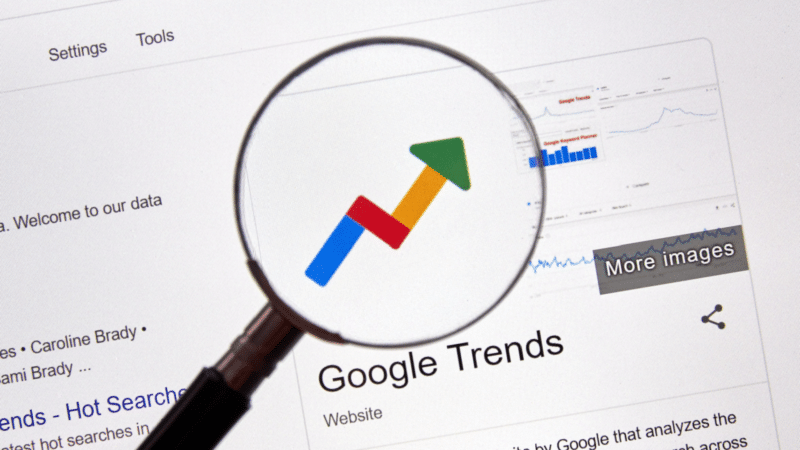
Have you ever read something in the press or on a media site and then searched Google to learn more about the topic?
Almost everyone has.
After reading an article about a product or idea, many people use a search engine to find deeper details about the topic or its elements.
This workflow can drive short- or long-term brand or non-brand keyword search patterns.
By analyzing these patterns, you can answer very strategic digital marketing, PR and SEO questions:
- What types of media placements drove these search patterns?
- What product messaging and positioning is driving audience interest?
- Should we consistently invest in PR or SEO instead of short-term campaigns?
- How do I steal my competitor’s best placements with our unique positioning?
- What publications should I use to test product positioning for a new go-to-market strategy?
- How do I increase the brand search for a new product launch?
These questions just scratch the surface of ways to apply this analysis to strategic search marketing, new category design or general product management.
First, let’s define brand search behavior in the context of digital media and search.
What is brand search behavior?How an audience searches out brand details as a result of either short-term or long-term engagement with brand messaging across other platforms.
Brand search behavior is a strong indicator of brand engagement.
As the audience learns about your brand or aspects of it, they will naturally search Google for more details.
Brand search behavior can work like this:
- Problem awareness: Search begins after the audience identifies a need, issue or potential solution from press, social or advertisements, often using non-branded keywords to learn more (e.g., “best fitness tracker”).
- Brand-specific search: After researching or learning about potential solutions, the audience may search for specific brands using branded keywords (e.g., “Fitbit” or “Fitbit data”).
- Deeper search for validation: Consumers compare brands and seek detailed information using keywords like “vs.” or “reviews” to evaluate options.
- Purchase decision: The audience might use search terms focused on finding the best price, how to buy or maybe contact (e.g., “buy Apple Watch” or “Apple Watch price”).
- Post-purchase search: After buying, consumers may search for support, tips or community engagement (e.g., “Fitbit phone”).
This process will provide deep insight into what drove this brand search behavior.
Analysis process overviewThis process identifies the messaging, sources and people driving an audience to search for a brand.
I use this tool stack to analyze:
- Google Trends.
- Glimpse.
- Ahrefs.
- Grok on the X platform.
The steps are fairly simple:
- Select competitor phasing: This is how people search for a competitor or your brand name.
- Uncover search patterns: Find short-term or long-term patterns for growth in brand search patterns.
- Find the source of influence: Find leading indicators of those patterns. What is driving brand search?
Starting by identifying the phrasing used to search the competitor (e.g., brand name) ensures you’re finding the right keyword phrases that an audience uses to find the brand website.
The leading indicators, or the source of influence, can identify patterns for:
- Growth.
- Decline.
- Random changes.
An audience can search for a brand name after just reading one or a few strategic placements or after constant exposure to a brand’s messaging.
I’ll use Lectric eBike as an example to show how this process works. They are an ebike brand that has gone from 37,000 to over 210,000 organic clicks per month, with over 150,000 clicks per month from brand searches.
Their brand search has grown in the short- and long-term over the past few years.
1. Select competitor and phrasingUse Semrush to identify the top variations of brand keywords. Go to Project > Overview > Organic research > Positions.
Select the top variation or run reports for all variations of the brand or product names.
In this example, the most popular brand variation is “Lectric eBike,” but people also use “lectric.”
In this case, we see that search terms get an estimated 33.1K searches per month.
But people also search for one of the ebike product lines, like the “lectric XP 3.0.”
These terms are a starting point for how the brand drives these searches.
 Brand search in Semrush
Brand search in Semrush
Use these keywords to search for patterns in Google Trends.
2. Identify patterns with Google TrendsBefore starting your search, use the Glimpse plugin (for Chrome) to update the Google Trends UI and add some very useful features.
This tool adds a trendline that shows seasonality or year-over-year (YoY) trends in an easy-to-understand format. This has saved me much time over exporting and analyzing the data.
Identify growth patterns (e.g., spikes or upward trends) like seasonality, year-over-year growth or random spikes.
The random spikes are my favorite because they can show short-term impact as a result of a specific event. Then, export the data to be analyzed later.
In this case, the growth in brand search interest started in the summer of 2022 but grew substantially in 2024.
Leading indicator questions:
- What causes the initial growth in the summer of 2022?
- What media coverage caused YoY growth in brand search in 2024 from 2023 and 2022?
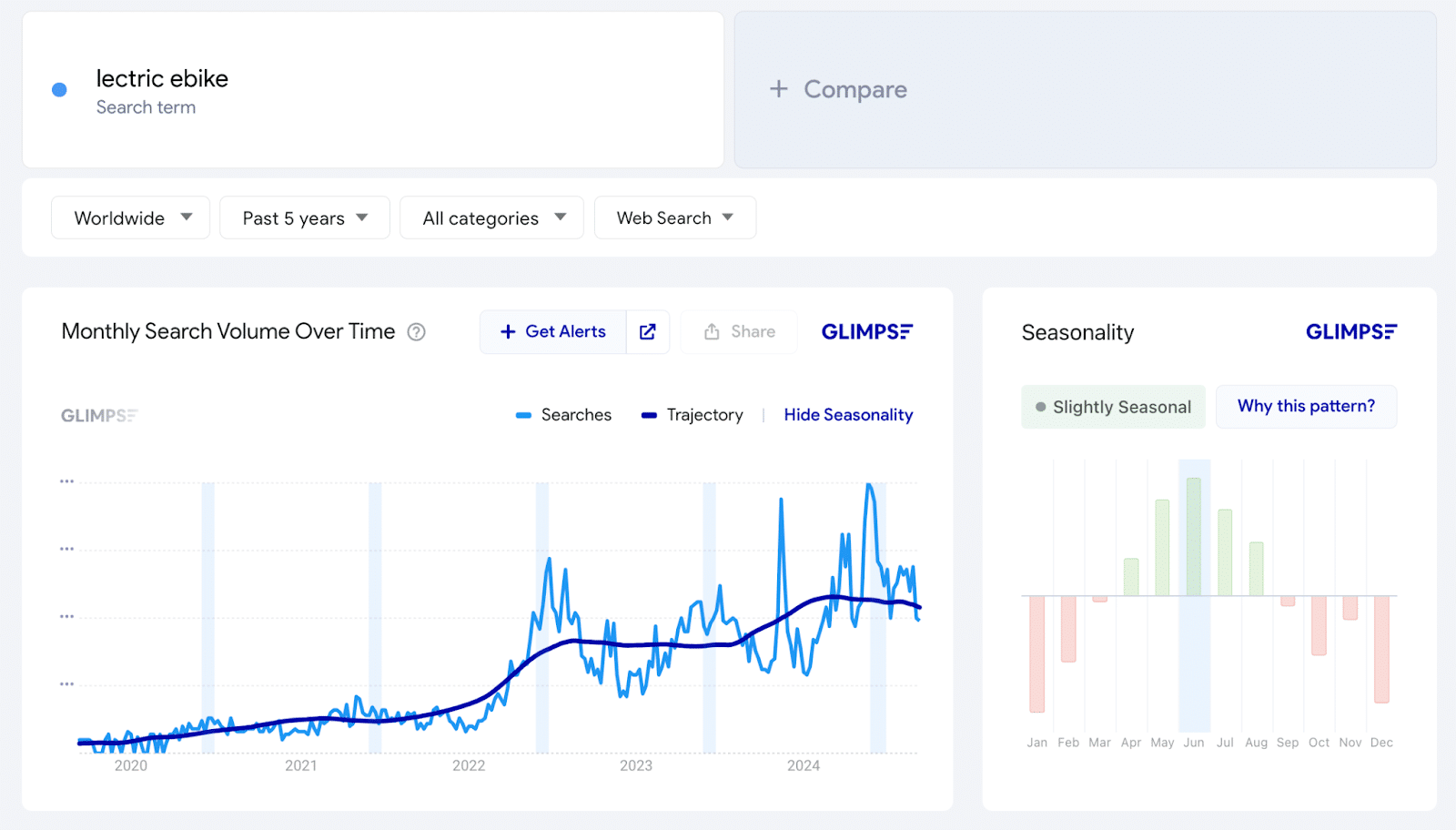 Google Trends + Glimpse report
Google Trends + Glimpse report
- Tip: Consistent media coverage can show YoY growth, especially during peak buying seasons. When analyzing growth, look at media coverage from the past 12 months, not just the month when the growth occurred.
Finding leading indicators can be challenging. Sometimes, a few media mentions can lead to a significant spike in interest. At other times, ongoing marketing efforts over several months or years may result in gradual YoY growth.
With the questions ready, use the tool stack to analyze the data and identify the media driving the search.
Get the newsletter search marketers rely on.
Business email address Sign me up! Processing... 3. Identify the source of influenceUse the tool stack to identify the source that influenced the growth patterns.
This doesn’t typically include analysis of YouTube videos, Instagram/TikTok or forms like Reddit, but it will provide fast insights into the messaging and trusted media sources.
For each pattern you want to understand, identify potential leading indicators.
Here’s the process:
- Grok for Twitter search: Ask Grok for media coverage of the brand name. Use this to identify potential trends in messaging or product launches.
- Ahrefs brand mentions: Run reports in Content Explorer to identify brand mentions over time. I haven’t found a better tool to do this process.
- ChartGPT analysis: Analyze all three Ahrefs reports to identify brand mentions to analyze.
Grok has real-time access to X’s content, so you can get recent information about X’s content and have Grok summarize the findings.
You can be creative with the prompts, but I like to ask for a summary of brand mentions.
When Grok summarized mentions of “Lectric eBikes” on X, it provided additional details that would require extensive research.
Grok quickly shows the new product launch coverage. The messaging of “quality at a low price” is consistent around the brand.
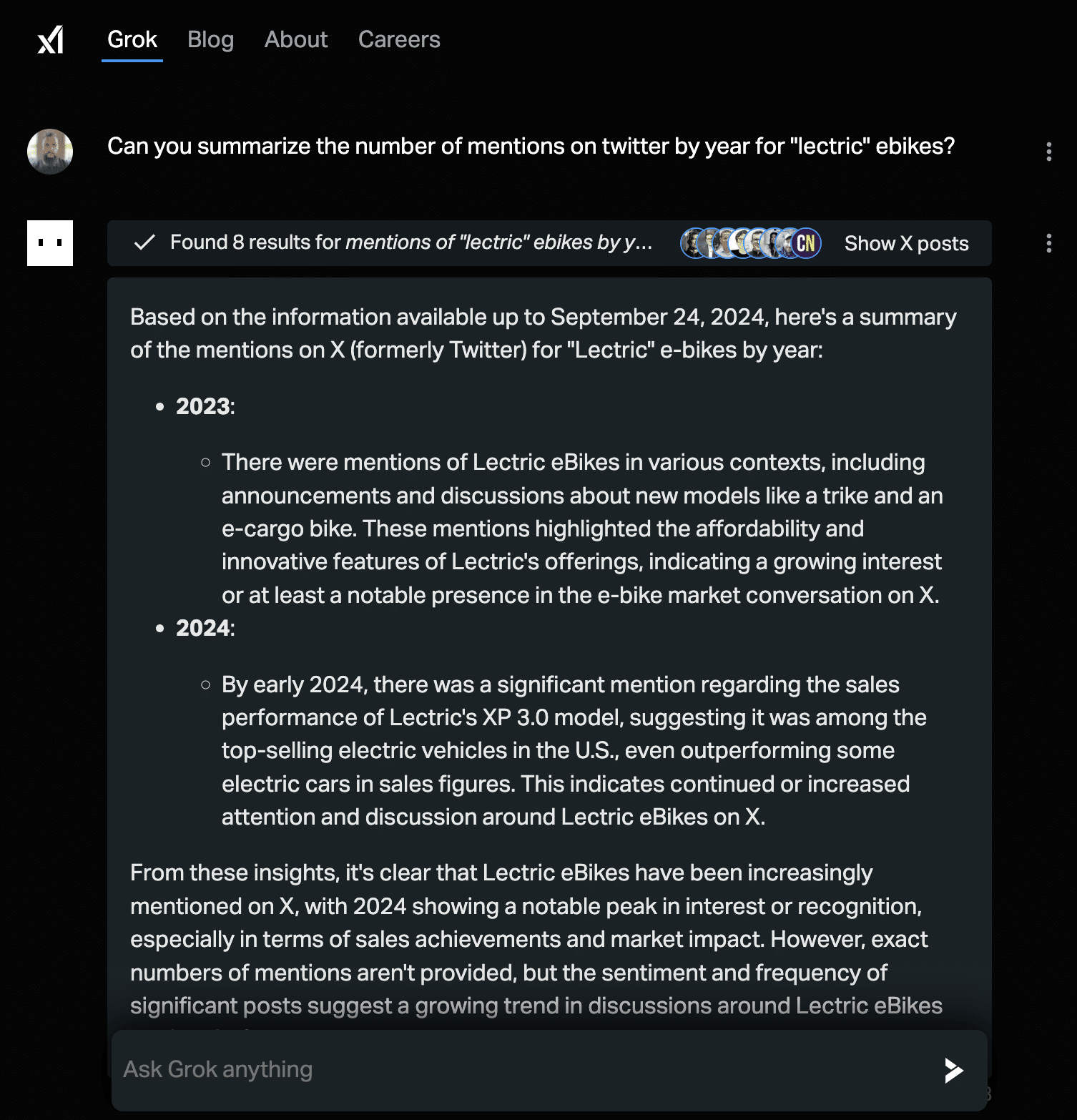 Grok prompt for brand mentions by year
Grok prompt for brand mentions by year
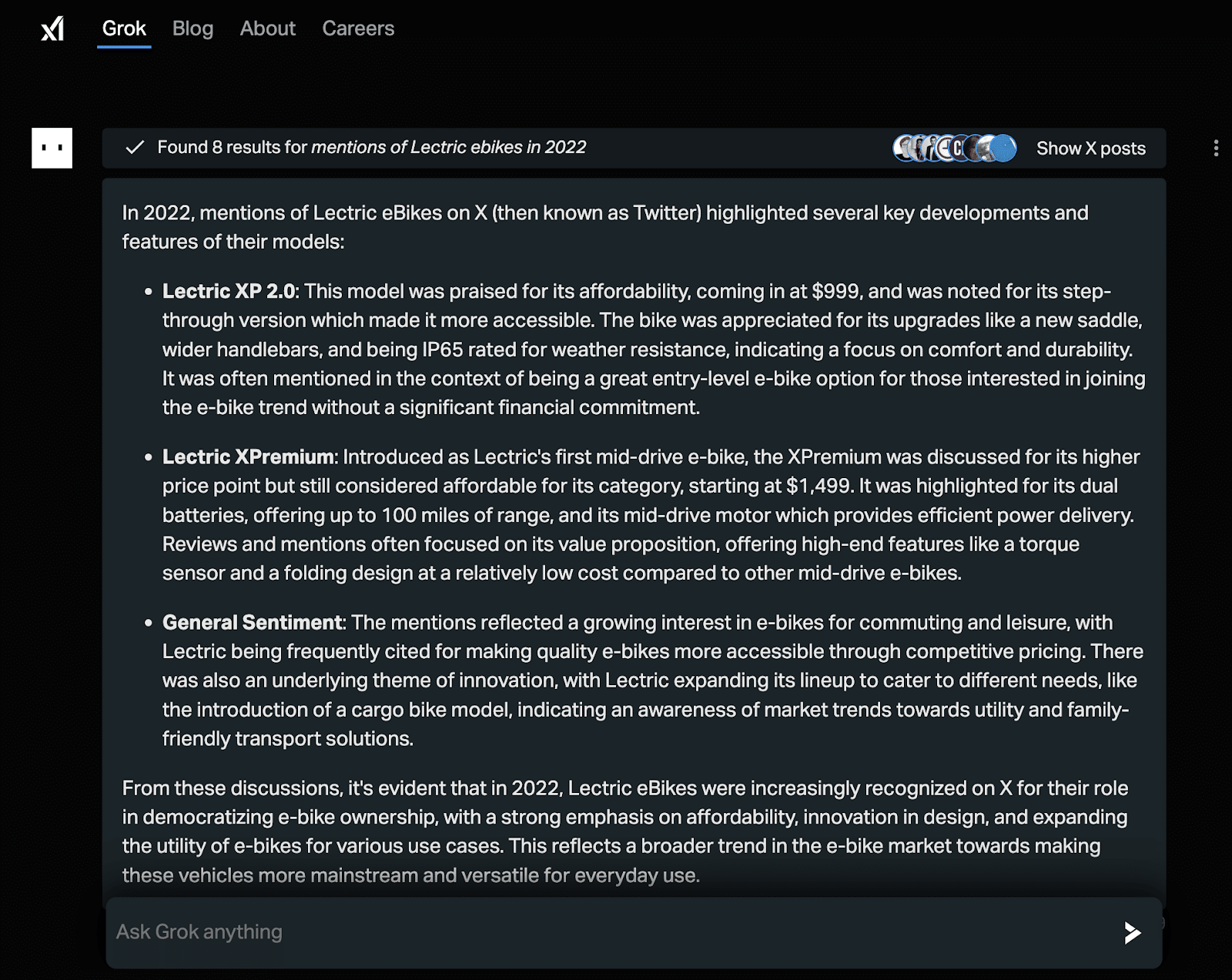 Grok prompt for brand mentions in 2022
Grok prompt for brand mentions in 2022
Grok has some insights, but I use Ahrefs to analyze the media coverage more deeply and validate Grok’s output.
Ahrefs brand mentionsUse the Content Explorer report in Ahrefs to identify historical trends in coverage of the brand on press, blogs and some message boards. Export the full list of publications to be uploaded to ChatGPT for analysis.
In this analysis, the Ahrefs bar chart illustrates the media story.
Mentions in 2021 were more consistent, while late 2022 saw a focus on holiday promotions. Both trends deserve further analysis.
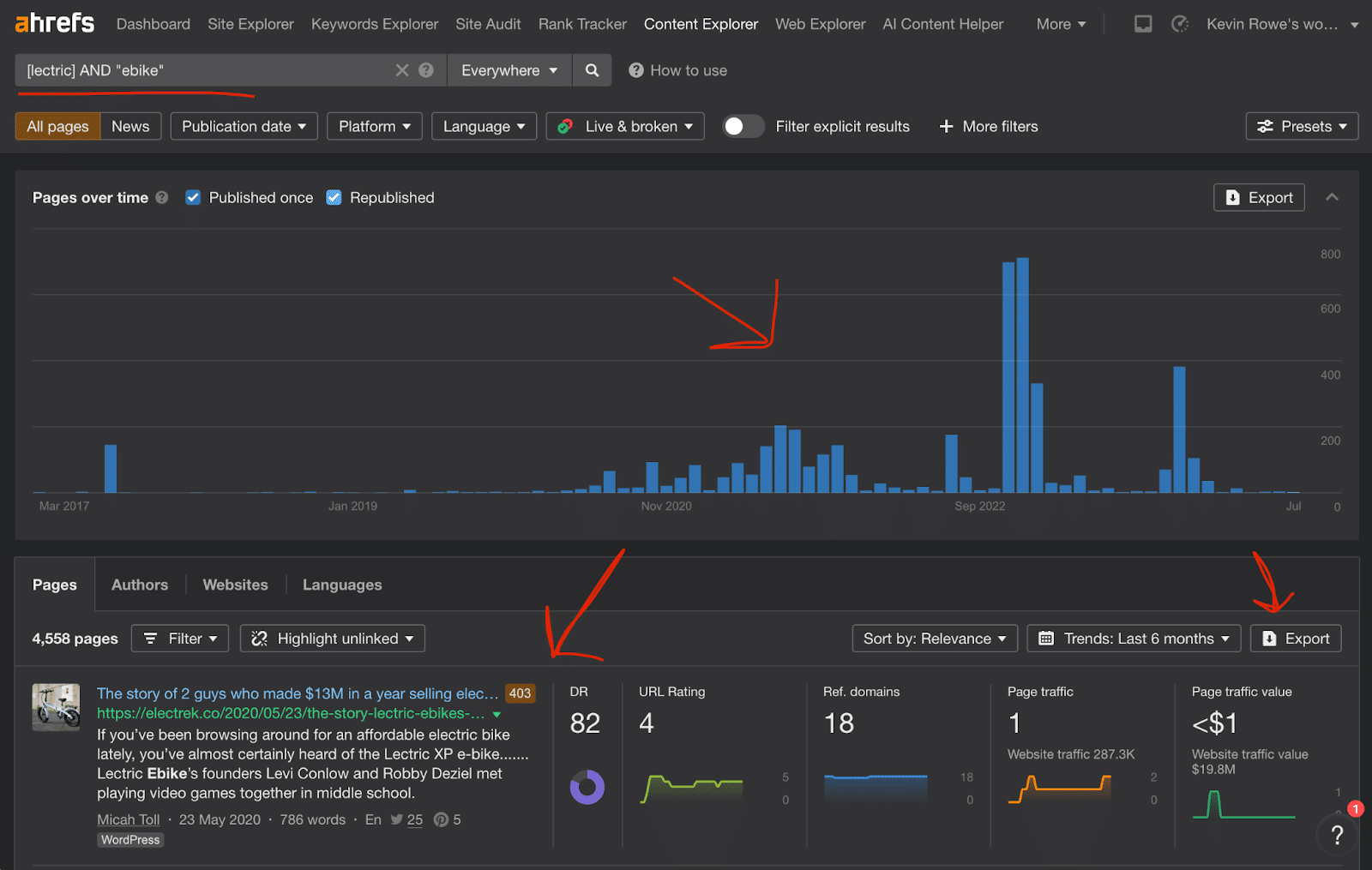
Tip:
- Test using phrase (use ” ” for phrase) or exact (use [ ] for exact) match Boolean queries to find more precise mentions. With “lectric,” Ahrefs returned a lot of mentions for “electric,” which was not a relevant brand mention.
Analyzing this data manually can be very laborious, so I use ChatGPT to take much of the work out of the analysis and find specific insights.
ChatGPT analysisUpload the Google Trends and Content Explorer exports to ChatGPT (I used 4o for this article) to analyze patterns in the brand mentions and brand search trends.
For this example, I quickly identified some key insights from correlation in Google Trends and brand mentions from Content Explorer.
From ChatGPT analysis, I found that the brand focused on some high-authority (e.g., Forbes) and also vertically targeted publications (e.g., Electrek). But also their consistent messaging about low cost and high quality is appealing to the audience on these publications.
I found these outputs from ChatGPT useful for understanding the media impact on patterns or identifying media to analyze further.
- Get key insights into leading indicators of random patterns/spikes or long-term trends
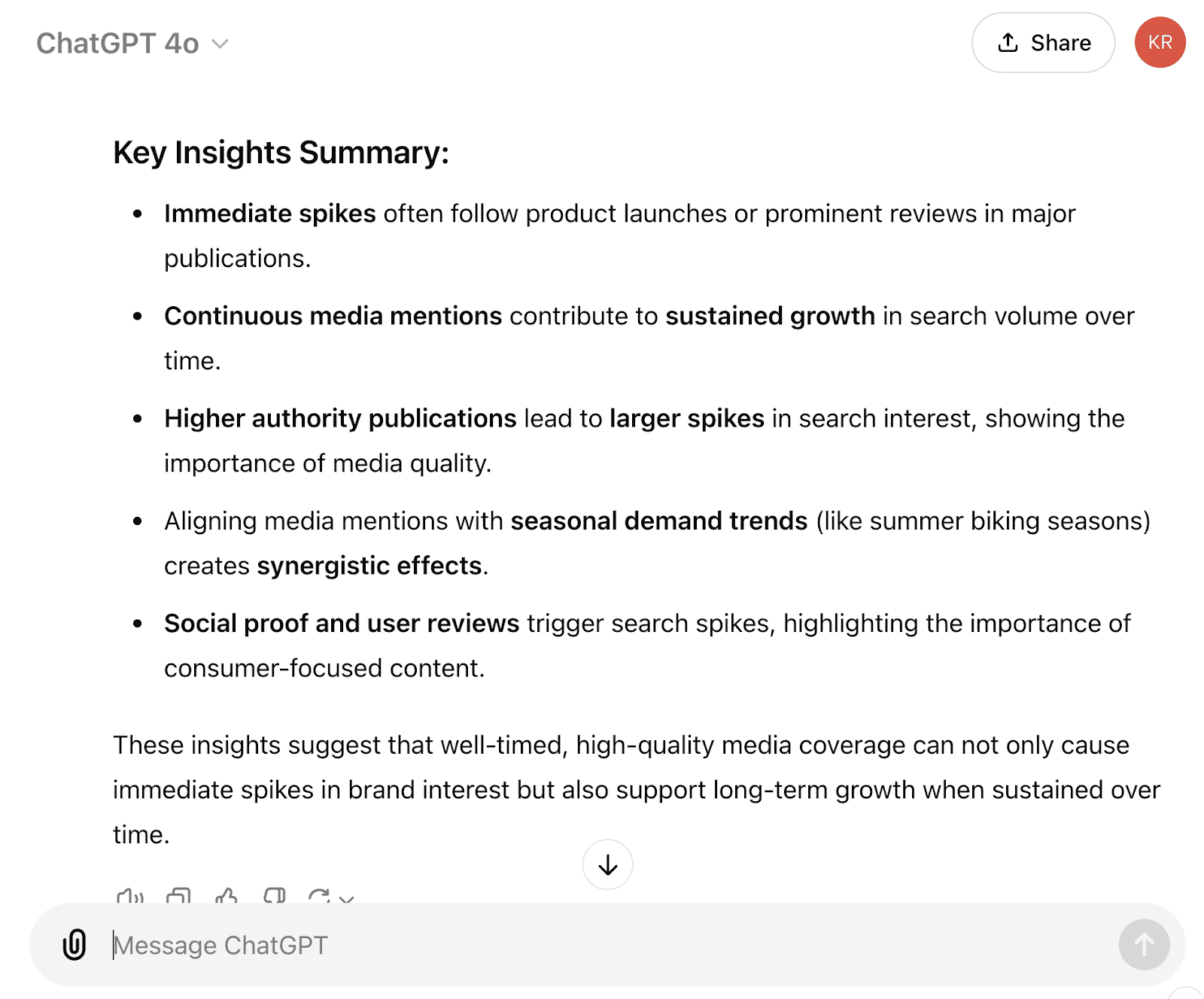 ChatGPT summary of key insights
ChatGPT summary of key insights
- Find general trends in media types that correlate with spikes or trends
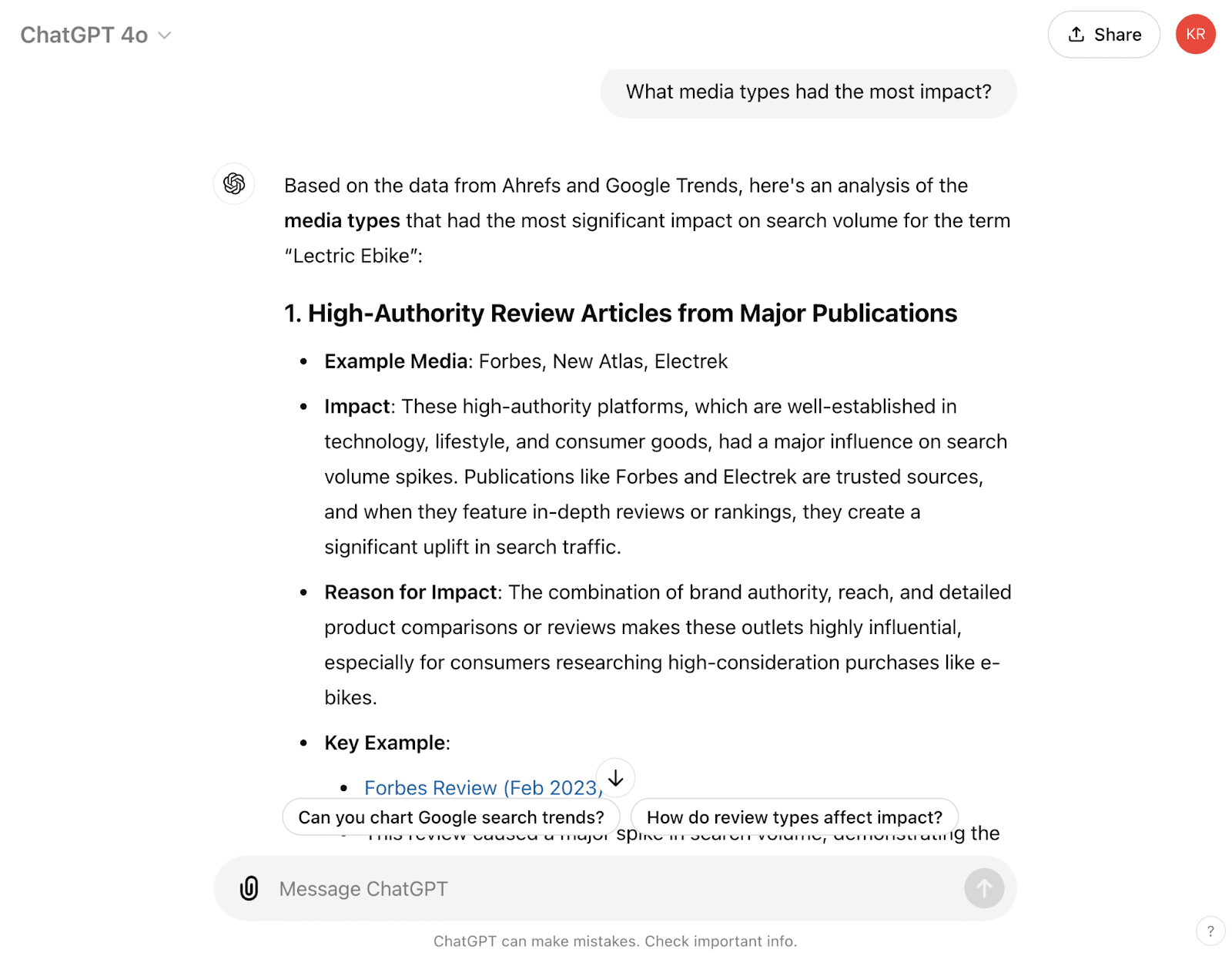 Most impactful media types
Most impactful media types
- Identify what specific sites could have driven spikes
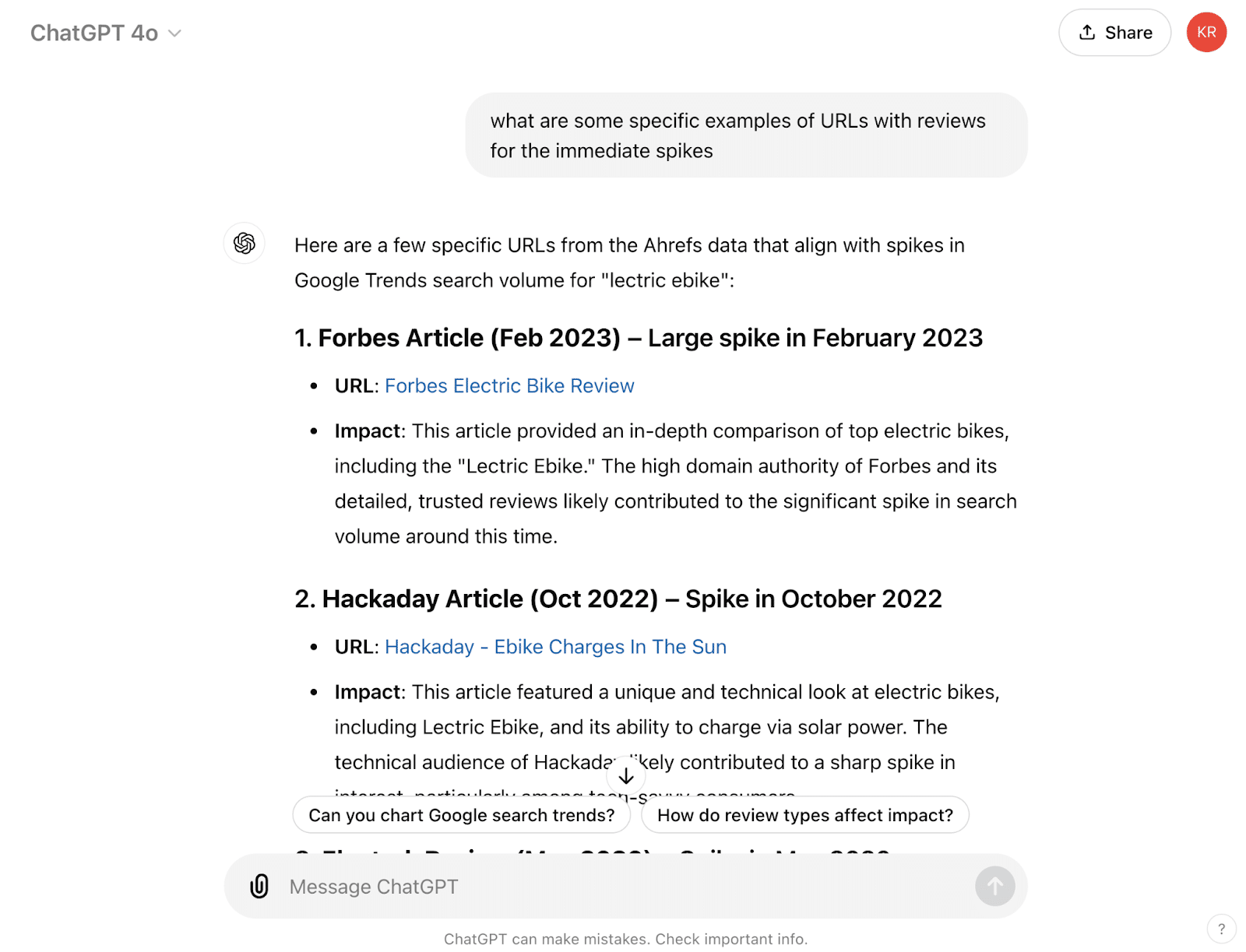 Examples of URLs that caused random traffic spikes
Examples of URLs that caused random traffic spikes
A big limitation is that this model doesn’t include larger market trends that can influence. But you can use Google Trends to help identify those as well.
BonusYou may want to use the PEST (political, economic, social, technological) model to identify major market factors that could contribute to these growth patterns. I know this doesn’t include competition, but it could fall under each of these categories.
The greater societal trends can have a big impact on demand for certain products or services.
Google Trends search for “ebike” grew substantially after the pandemic started in 2020.
It might be caused by a growing number of people are thinking about a healthier lifestyle, which is helping to drive this demand.
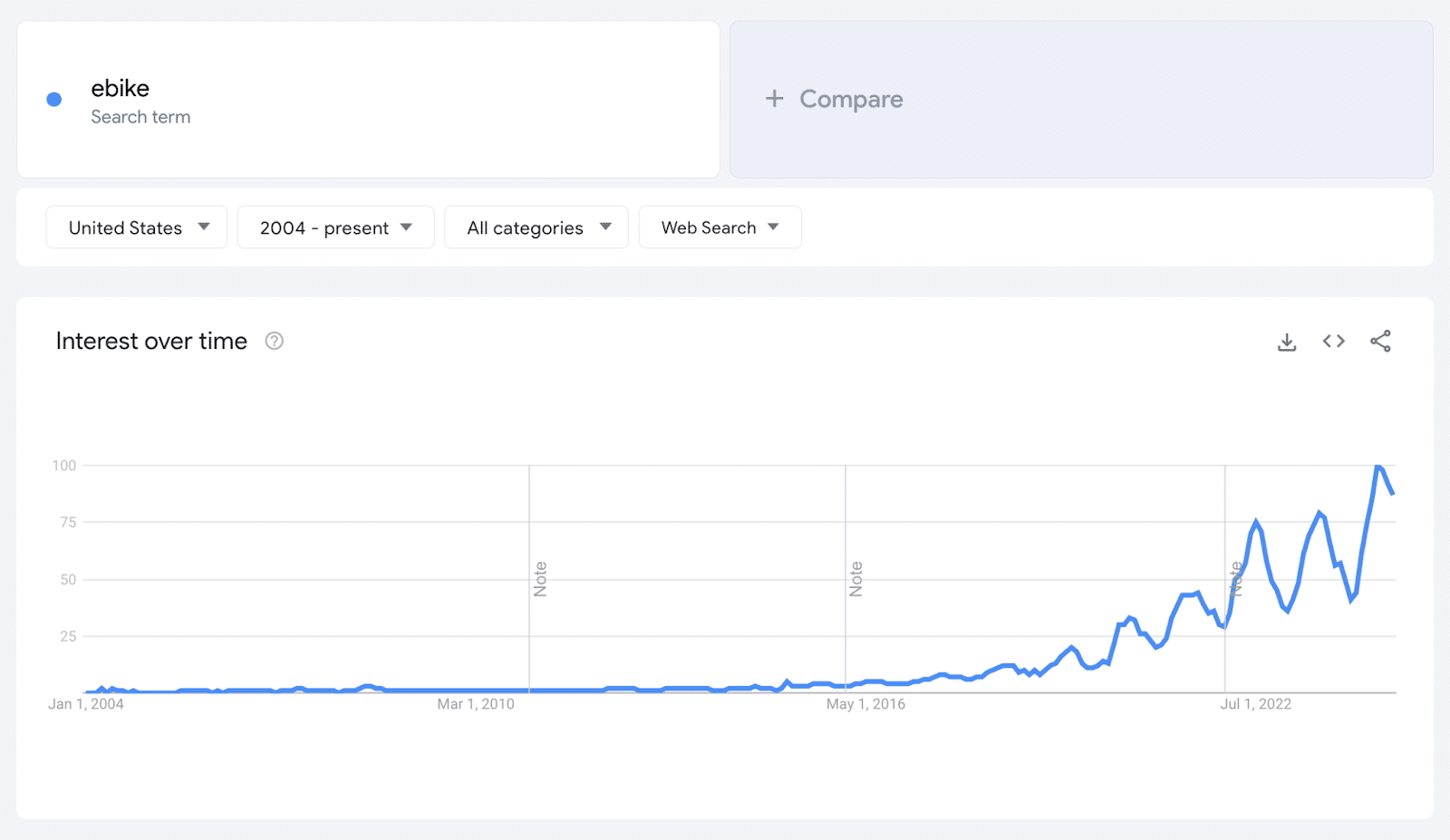 Growing search interest in Google trends for “ebike”
Growing search interest in Google trends for “ebike”
- Tip: When uploading, describe the data and the source to ChatGPT and ask for the field names. Then ChatGPT will likely have to clean the data.
This article serves as a guide for conducting your own competitor search behavior analysis.
By applying the insights shared here, you can uncover effective strategies to surpass your competitors in organic search and drive sustainable revenue growth.
Notes on data and analysis quality
- Ahrefs: While useful, it doesn’t account for advertising, social media, or physical publications.
- Grok: Provides real-time access to X data, but it’s unclear how many brands are mentioned beyond content from the company or its team members.
- Google Trends: Doesn’t capture all searches and includes some crawler data. The “note” markers could influence growth, but there’s no strong evidence of significant distortion over time.
- ChatGPT: Lacks access to real-time web data and may generate inaccurate insights (“hallucinations”). This can be mitigated by manually verifying media placements.
